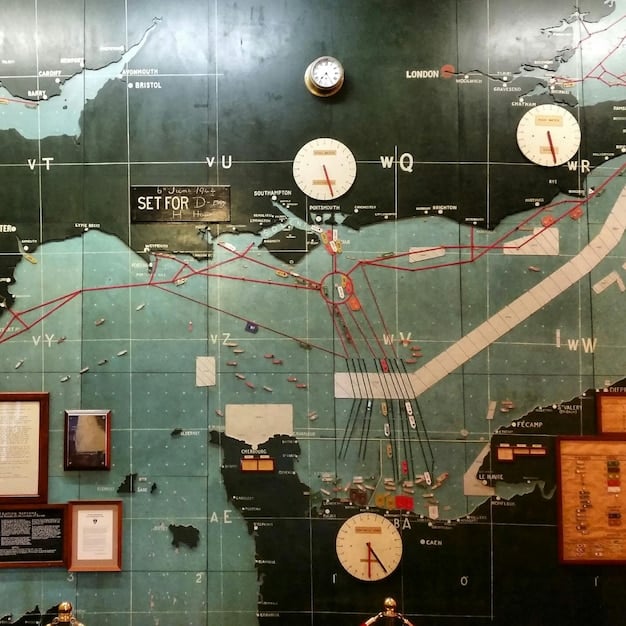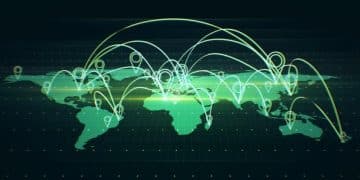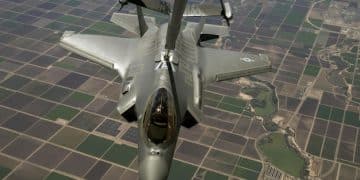US-Iran Nuclear Deal: Will Renegotiation Happen by 2025?

The potential renegotiation of a nuclear deal between the United States and Iran by the end of 2025 remains highly uncertain, contingent upon complex geopolitical factors, domestic political shifts, and the evolving strategic interests of both nations.
The intricate dance between the United States and Iran, particularly concerning its nuclear program, consistently captures global attention. A central question that continues to loom is whether the US Relations with Iran: Will the Nuclear Deal Be Renegotiated by the End of 2025? This complex issue involves historical grievances, shifting political landscapes, and the delicate balance of regional power.
The JCPOA’s Troubled Legacy and the Path Forward
The Joint Comprehensive Plan of Action (JCPOA), commonly known as the Iran nuclear deal, represented a landmark agreement in 2015, aimed at preventing Iran from developing nuclear weapons in exchange for sanctions relief. However, its trajectory has been fraught with challenges, fundamentally altering the landscape of US-Iran relations. Understanding its turbulent history is crucial for assessing future prospects.
The original deal, signed by Iran, the five permanent members of the UN Security Council (China, France, Russia, United Kingdom, United States), Germany, and the European Union, was hailed by some as a triumph of diplomacy and condemned by others as inherently flawed. Its implementation faced immediate scrutiny and later, outright withdrawal by the United States under the Trump administration in 2018. This unilateral action significantly undermined the agreement, leading to Iran’s gradual rollback of its commitments and an escalation of nuclear activities. The Biden administration, while expressing a desire to return to the deal, has faced considerable obstacles, including Iran’s hardening stance and the domestic political costs of a direct return. The initial hope of a swift restoration of the JCPOA has largely dissipated, replaced by a nuanced understanding that any future engagement will likely require a fresh approach, possibly incorporating new elements or addressing previous shortcomings.
Key aspects of the original JCPOA:
- Limitations on uranium enrichment levels and stockpiles.
- Redesign of the Arak heavy water reactor.
- Enhanced inspections and monitoring by the International Atomic Energy Agency (IAEA).
- Phased sanctions relief from the UN, US, and EU.
The withdrawal not only strained relations but also created a trust deficit that makes any renegotiation inherently difficult. Both sides harbor deep suspicions, making constructive dialogue a lengthy and arduous process. The Iranian government, under former President Rouhani and now President Raisi, has consistently demanded the complete lifting of sanctions as a prerequisite for full compliance, while the US has insisted on a return to the 2015 limits. This fundamental disagreement on the sequence of steps has been a primary stumbling block. The past failures underscore the need for a comprehensive framework that addresses the concerns of all parties, not just the original signatories.
Geopolitical Shifts and Regional Dynamics
The broader geopolitical context significantly influences the potential for renegotiating the nuclear deal. The Middle East is a crucible of shifting alliances, proxy conflicts, and evolving power dynamics that often intersect with the Iran nuclear issue. Regional players, particularly Saudi Arabia and Israel, view Iran’s nuclear ambitions with intense apprehension, shaping their diplomatic engagement with world powers. Their security concerns often conflict with the strategic objectives of the US or European nations.
The ongoing conflicts and humanitarian crises in Yemen, Syria, and Lebanon, where Iran holds considerable influence through its proxies, add layers of complexity. Any deal with Iran inevitably impacts the delicate balance of power in these theaters. Countries in the Gulf Cooperation Council (GCC) have voiced strong reservations about the JCPOA, arguing it did not adequately address Iran’s ballistic missile program or its regional destabilizing activities. Their proactive engagement with both Washington and Tehran indicates a desire for regional security that extends beyond nuclear limitations.
Regional actors and their concerns:
- Saudi Arabia: Fears Iranian hegemony and proxy conflicts.
- Israel: Views Iranian nuclear capabilities as an existential threat.
- Turkey: Seeks regional stability and economic opportunities.
- Iraq: Navigates complex relations with both Iran and the US.
In addition, the growing geopolitical competition between major powers, notably the US, China, and Russia, also plays a role. China and Russia, both signatories to the original JCPOA, have maintained closer ties with Iran and often express skepticism towards US demands. Their economic interests and strategic alliances with Tehran can complicate efforts to present a united front or impose new leverage. The evolving global energy landscape, particularly the demand for oil and gas, also confers a degree of geopolitical leverage to Iran, enabling it to resist certain pressures. Therefore, any move towards renegotiation cannot occur in a vacuum but must consider these intricate regional and global dynamics.

US Domestic Politics and Executive Priorities
The internal political landscape of the United States exerts a profound influence on the approach to Iran and the prospects for a nuclear deal renegotiation. Different administrations have adopted vastly divergent strategies, often reflecting partisan divides and contrasting foreign policy philosophies. This domestic variability makes long-term predictability challenging for international partners and adversaries alike. The current administration, while signaling a willingness to engage, must navigate a divided Congress and a skeptical public.
Presidential elections, legislative priorities, and the influence of powerful lobbying groups (both pro-deal and anti-deal) shape the parameters of what is politically feasible. The 2024 US presidential election will undoubtedly be a pivotal factor. A change in administration could lead to another dramatic shift in policy, potentially reversing any progress made under the current leadership. The lessons from previous policy reversals, such as the US withdrawal from the JCPOA, highlight the fragility of agreements when insulated from bipartisan consensus.
Considerations for US domestic policy:
- Bipartisan support for any lasting agreement.
- Influence of domestic lobbying groups.
- Congressional oversight and approval processes.
Moreover, the US public’s perception of Iran fluctuates, often shaped by media coverage of regional tensions, human rights issues, and Iran’s missile program. Public opinion, while not always dictating policy, can establish boundaries for executive action. The administration’s ability to “sell” a new or reformed deal to the American public and secure congressional buy-in will be critical. This requires transparent communication, a clear articulation of national security interests, and a compelling argument for diplomacy over confrontation. Without broad domestic support, any renegotiation attempt risks being short-lived or politically unsustainable, echoing the fate of its predecessor.
Iran’s Internal Dynamics and Strategic Calculus
On the Iranian side, internal political stability, ideological considerations, and economic pressures significantly shape the regime’s approach to the nuclear issue and its willingness to engage in renegotiation. The complex interplay between the Supreme Leader, the President, the Revolutionary Guard Corps (IRGC), and various hardline and reformist factions dictates the country’s strategic calculus. The conservative-dominated government under President Ebrahim Raisi has adopted a more assertive and less yielding stance than previous administrations.
Iran’s nuclear program is deeply intertwined with its sense of national sovereignty and resistance against external pressures. The country views its nuclear capabilities, even for peaceful energy, as a fundamental right and a deterrent against perceived threats. The experience of the US withdrawal from the JCPOA reinforced a strong sense of distrust, leading many Iranian officials to believe that the US cannot be a reliable partner. This sentiment makes concessions challenging, as any perceived weakness could be exploited domestically by hardline elements.
Factors influencing Iran’s stance:
- Perceived need for nuclear deterrence.
- Influence of hardliners and the IRGC.
- Economic pressures and sanctions.
- Public opinion on Western engagement.
Furthermore, the economic hardships imposed by US sanctions remain a critical factor. While sanctions are designed to compel Iran to change its behavior, they also harden the resolve of some factions, who advocate for a “resistance economy” rather than capitulation. The Iranian government’s demands for the complete lifting of sanctions are not merely negotiating tactics; they reflect a genuine belief that economic relief is a prerequisite for any meaningful engagement. The ongoing protests and internal dissent, while not directly tied to the nuclear program, could also affect the regime’s willingness to appear conciliatory on a matter of national pride. Therefore, any successful renegotiation must acknowledge these internal economic and political realities.
The Role of International Actors and Multilateralism
The prospects of renegotiating the nuclear deal are not solely dependent on the bilateral relationship between the US and Iran. The involvement of other international actors, especially the remaining signatories to the JCPOA (China, France, Germany, Russia, and the UK), as well as the European Union (EU), is crucial. These nations have consistently advocated for a diplomatic resolution and have often played a mediating role. Their continued commitment to the JCPOA, even after the US withdrawal, highlights a multilateral approach to non-proliferation.
The P4+1 (China, France, Russia, UK, and Germany) and the EU have actively sought to keep the JCPOA alive, believing it remains the best instrument for preventing Iran from acquiring nuclear weapons. Their diplomatic efforts, often through informal channels, have aimed at de-escalation and facilitation of dialogue. The European Union, in particular, has devoted significant diplomatic capital to reviving the deal, acting as a crucial coordinator in past negotiations. Their economic ties with Iran, while constrained by US sanctions, provide an incentive for finding a sustainable solution.
Key international players:
- European Union (EU): Diplomatic facilitator and mediator.
- China: Economic partner and strategic ally of Iran, cautious on sanctions.
- Russia: Geopolitical player, critical of US unilateralism, nuclear technology supplier.
- United Kingdom, France, Germany: Supporters of a diplomatic solution, alignment with EU positions.
However, the effectiveness of multilateralism is often challenged by divergent national interests and the shadow of US sanctions. While these international actors endorse diplomacy, their ability to influence both Washington and Tehran is limited. China and Russia, for example, have their own strategic relationships with Iran, often diverging from Western interests. Their reluctance to wholeheartedly support new, tougher sanctions on Iran can undermine a unified international front. The success of any future renegotiation will heavily depend on the ability of these international actors to forge a credible, coherent, and sustained collective approach that addresses the concerns of all parties and provides a pathway for mutual trust-building.

Technical Aspects of Nuclear Verification and Compliance
Beyond the political and diplomatic complexities, the technical aspects of nuclear verification and compliance form the bedrock of any credible nuclear deal. The International Atomic Energy Agency (IAEA) plays an indispensable role in monitoring Iran’s nuclear activities and ensuring adherence to non-proliferation commitments. The Agency’s ability to conduct robust inspections and access key sites is paramount for building international confidence.
The original JCPOA provided for an extensive and intrusive verification regime, including continuous monitoring and access to Iran’s declared and undeclared nuclear sites. Following the US withdrawal and Iran’s subsequent reduction of its commitments, the comprehensive nature of these inspections has been curtailed. Re-establishing and potentially enhancing these verification mechanisms would be a central point of any renegotiation. Questions regarding advanced centrifuges, uranium enrichment levels, and the transfer of technical knowledge remain critical.
Technical challenges in renegotiation:
- Re-establishing IAEA’s full monitoring capabilities.
- Addressing advancements in Iran’s nuclear technology since 2018.
- Defining acceptable levels of uranium enrichment and stockpiles.
- Ensuring transparency regarding past and present nuclear research.
Moreover, the technical advancements made by Iran during the hiatus from full JCPOA compliance, such as the operation of more advanced centrifuges and the accumulation of higher-enriched uranium, complicate a straightforward return to past limits. Any new agreement would need to account for these developments, perhaps requiring new baseline measurements or adjusted verification protocols. The technical details are not merely academic; they are intrinsically linked to the political viability of the deal, as they determine the verifiable “breakout time” – the time Iran would need to produce enough fissile material for a nuclear weapon. Therefore, experts from the IAEA and member states will need to play a crucial role in shaping a technically sound and verifiable agreement.
| Key Aspect | Brief Description |
|---|---|
| ⚛️ JCPOA Evolution | Initial deal, US withdrawal, and Iran’s reciprocal actions complicate future talks. |
| 🌍 Geopolitical Context | Regional rivalries and global power dynamics heavily influence negotiation prospects. |
| 🗳️ Domestic Politics | US and Iranian internal politics, elections, and public opinion shape diplomatic room. |
| 🔬 Verification Challenges | Technical complexities of monitoring Iran’s advanced nuclear capabilities. |
Frequently Asked Questions
The JCPOA is an international agreement signed in 2015 between Iran and several world powers. It aimed to restrict Iran’s nuclear program to prevent it from developing nuclear weapons in exchange for relief from economic sanctions. The deal included stringent verification measures by the International Atomic Energy Agency.
The US withdrew from the JCPOA under the Trump administration, citing that the deal was insufficient to curb Iran’s nuclear ambitions, ballistic missile program, and regional activities. The administration argued the deal had sunset clauses that would allow Iran to resume nuclear activities in the future.
Key obstacles include a deep trust deficit between the US and Iran, Iran’s advancements in its nuclear program since 2018, differing demands on sanctions relief, complex regional dynamics, and internal political pressures within both countries. The US presidential election also adds significant uncertainty.
Regional actors, particularly Saudi Arabia and Israel, generally view a nuclear deal with skepticism. They are concerned that any agreement might not adequately address Iran’s ballistic missile program or its support for regional proxy groups, which they perceive as destabilizing. Their security interests heavily influence their stance.
While diplomatic channels remain open, the likelihood of a comprehensive renegotiation by the end of 2025 is uncertain. The numerous political, technical, and trust-related challenges require extensive and delicate negotiations, which are often protracted. The outcome will depend on shifts in political will and strategic priorities from all parties involved.
Conclusion
The question of whether the US and Iran will renegotiate a nuclear deal by the end of 2025 is less a matter of “if” and more a challenging “how” and “when.” The path forward is fraught with complexities, rooted in historical mistrust, evolving geopolitical realities, and the intricate domestic political landscapes of both nations. While the desire for a diplomatic resolution persists among many international actors, the impediments are substantial. Any future agreement would likely require innovative approaches that transcend the limitations of the original JCPOA, addressing not only nuclear concerns but also broader regional stability. The end of 2025 serves as a crucial strategic marker, yet the dynamic nature of these relations suggests that a resolution, if it comes, will be the product of sustained, intricate, and often unpredictable diplomatic efforts.





